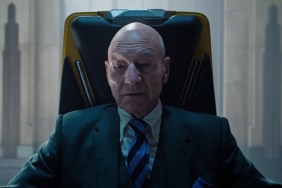
7 out of 10
Cast:
James McAvoy as Charles Xavier / Professor X
Michael Fassbender as Erik Lehnsherr / Magneto
Jennifer Lawrence as Raven Darkhölme / Mystique
Oscar Isaac as En Sabah Nur / Apocalypse
Nicholas Hoult as Hank McCoy / Beast
Tye Sheridan as Scott Summers / Cyclops
Sophie Turner as Jean Grey
Kodi Smit-McPhee as Kurt Wagner / Nightcrawler
Evan Peters as Peter Maximoff / Quicksilver
Rose Byrne as Moira MacTaggert
Alexandra Shipp as Ororo Munroe / Storm
Olivia Munn as Elizabeth Braddock / Psylocke
Ben Hardy as Warren Worthington III / Angel / Archangel
Lucas Till as Alex Summers / Havok
Josh Helman as William Stryker
Lana Condor as Jubilation Lee / Jubilee
Hugh Jackman as Logan/Wolverine
Directed by Bryan Singer
X-Men: Apocalypse Review:
Director Bryan Singer (X-Men: Days of Future Past) famously said of the first X-Men, “you really have to make one of these movies in order to learn how to make one of these movies.” By now, having directed four entrants in the series, Singer can make one of these with his eyes closed, which is the root of the good and bad to be found in X-Men: Apocalypse.
Singer and his co-horts (many of them also veterans of the series) deliver well-crafted thrills and a notable lack of experimentation, falling back on elements they know will work and amping them up to eleven. The one big break with the past, and the delimiter which will determine whether the film works for you or not, is the titular villain himself (or at least what he represents). A powerful mutant who ruled the world in the ancient past, the self-styled Apocalypse (Isaac) has reawakened into a world of mutants and mayhem and is ready to fulfill his pledge to remake mankind in his own image.
The modern X-Men, and particularly the film series, have primarily been inward looking; its antagonists and primary conflicts were inevitably tied to the core metaphor of mutants as stand-ins for all oppressed minorities. That has made for potent storytelling but also created a risk of repetition if nothing new was ever added, which meant at some point the series was going to have to look outside itself for a source a conflict.
Doing that also requires coming up with a new way to relate returning characters inter- and intrapersonal issues to the larger story without making it seemed forced; Singer and co-writers Simon Kinberg, Michael Dougherty and Dan Harris never quite get there. Apocalypse himself is ill-defined with little going on inside beyond a typically grandiose goal about destroying the world to save it, leaving the filmmakers with a hefty load of characters to balance and no fulcrum beneath them.
The end result of this process (which includes many characters without well-defined characters merely because it’s the end of the storyline begun in X-Men: First Class) that leaves many characters standing around with little to do. Rose Byrne’s Moira MacTaggert is the worst recipient of that, but even Lawrence’s Mystique and Fassbender’s Magneto, despite strong re-introductions, take a back seat for much of the film waiting for someone else to do something.
Those someone’s tend to be the New Mutants – Cyclops (Sheridan), Jean Grey (Turner) and Nightcrawler (Smit-McPhee) – who get the double benefit of recognizable character traits ported down from their older selves while also getting to play the part of newest inductee to a strange new world, one which is still coming to grips with the heroism displayed by Mystique in Days of Future Past. The decision is obvious as newcomer is much easier to write than old hand – they’re perfect receptacles for exposition and have a natural story arc as they start out without knowledge and gain it over the course of the rising action – but it also takes Apocalypse’s legs out.
Singer seems to be after a ‘it’s the same, but different’ vibe, but it’s ‘the same’ part which largely wins out; still his understanding of the material and how to present it, particularly from a visual perspective, remains as sharp as ever. Singer was one of the first to really figure out superhero mayhem – the Nightcrawler introduction from X2 was one of the first touchstones for how such super people should appear in the modern effects age and has influenced many a superfight since – and his skill in that regard has not diminished, which quickly comes into play as the re-awakened Apocalypse begins surrounding himself with a cadre of powerful mutants to do his bidding, including a kidnapped Charles Xavier.
It’s worth noting that for most of its life, X-Men has prided itself on that down-to-Earth view of superheroics particularly in its stylistic choices even as newer, younger series moved closer and closer to the four-color world. [It’s also worth remembering that this is the franchise which helped birth the modern superhero craze.] Longtime Singer partner in crime Newton Thomas Siegel was one of the first to get the idea of a realistically-presented super world, using a palette of desaturated greens and browns (and the odd snow white).
He and production designer Grant Major of The Lord of the Rings fame continue that trend here, at least for the first half of the film until the Four Horsemen arrive and everything goes crazy. With the coming of Apocalypse and his flair for the mythological (recognizing it as levers of population control), costume designer Louise Mingenbach is for the first time free to lose the black leather and make with all the colors of the rainbow splattered onto very comic book faithful designs. It’s a moment which ties in with the rise of Apocalypse and his plan to literally tear the world down and rebuild it.
It’s the most comic-booky thing Singer has ever attempted within the series and it shows. Apocalypse is one of the best-looking films of the franchise.
At the same time, many of the creative decisions are based on re-doing what has worked before – experimentation ends at the color palette – and the overt familiarity soon becomes more hindrance than help. If you really liked the big Nightcrawler and Quicksilver introductions in previous films, be prepared to sit through them again, only more so. If you miss Colonel Striker and the halls of Weapon X, you will see them again as the second act sees the X-Men spirited off to the well-worn halls of Alkali Lake for no particular reason other than to work in a cameo of a well-loved character and because it’s what has gone before.
Yes, it gives the New Mutants a chance to work together as X-Men for the first time, but that could have been done with the Four Horsemen and developed conflict there instead of putting it on hold for thirty minutes or so. If anything, Apocalypse frequently feels like a Singer’s laundry list of things he either knows he likes to have in X-Men films or elements he couldn’t squeeze in before (Cyclops getting his powers for the first time, Archangel and his metal wings) and he’s ticking his way through them one by one.
Still, for all the backtracking and characters who exist only to take part in action scenes (and the series has always suffered from that to some degree), X-Men: Apocalypse is too entertaining to write off as some franchise-killing disaster like The Last Stand or even a mundane closing sign. It does, however, suggest the tank is running dry and without a new hand at the wheel or some fantastic new ideas, the end may be in sight.









